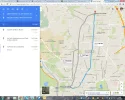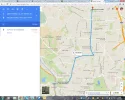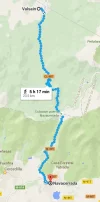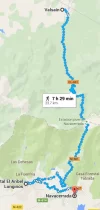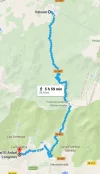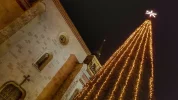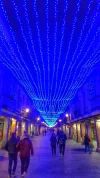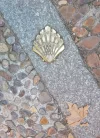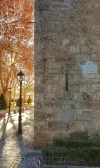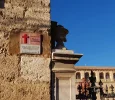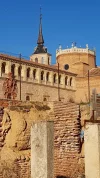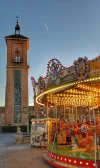Since I am still jet lagged and in that hard transition back to life as we know it, what better way to spend the early morning hours than compiling some notes for future peregrinos on the Camino de Madrid. I'll break this up into several posts, since I've written a lot. Alipilgrim, Caminando, and I were all there within days of each other, so they may have information on other places than the ones i stayed in (but it was a nice touch to read messages from Caminando as I followed in his footsteps, thanks!). So here goes:
I took two weeks to walk from Madrid to Sahagun on the Camino de Madrid, and I have to say that if only just a few more peregrinos would come on over, it would be a perfect mix of companionship and solitude. As it was, I met two Spanish walkers and had interactions with about 6 or 7 cyclists, all Spanish. This Camino is generally exceptionally well marked, and generally very pilgrim-friendly. Aside from the day from Cercedilla to Segovia, the days are flat-ish and tend either to pine forests or ag lands. It was quite beautiful in late May, and the temperatures were very agreeable.
I have made a lot of walking notes that I will be sending to Johnnie Walker for his revisions to the online CSJ guide, which was invaluable. If you will be on this Camino before those revisions appear, just PM me and I'll send them along.
But here are my stages with comments on accommodations:
Day 1 -- From Plaza de Castilla to Colmenar el Viejo (27 km). No pilgrim accommodations, and as others have noted, it was impossible to find the Hostal Chabeli, notwithstanding its prominent sign right near the Ayuntamiento. In the end, it was Hostal el Chiscon, 44 E for B&B. Breakfast served early enough for walkers, especially if you plan to walk only 16 to Manzanares.
Day 2 -- Colmenar el Viejo to Manzanares el Real (16 km). Nice castle for visiting. Stayed in the refugio in the Ermita on the Pena Sacra. It was a bit complicated and luckily I ran into two Spanish peregrinos in the tourist office at Manzanares. or I would have given up and gone to the hotel. The refugio (a term used on this camino. I believe, to indicate that the accommodations are not just for pilgrims) is run by the town priest, who has the key. He will register you and give you the key if there is not a conflict with (religious) retreats. You must visit the priest at his house, which is very close to the tourist office, and the hours he is available seem to depend on the day. Though the sign on his door said that you could register for the refugio at 1:30, we didn't find him till well after 3:00 p.m., but we used the time to eat a decent meal in a restaurant.
The refugio is about two km out of town and up -- it's located on a big rock which has fantastic views of the surrounding Guadarrama mountains. The refugio is not totally off-Camino. The turn-off comes about 20 minutes on your way up to the refugio. This means that whoever has to return the key to the priest's house the next morning doesn't add 4 km to his/her day, but it is kind of a hassle. If you're not alone, of course, you can leave your pack at the intersection of the Camino, which makes the trip much easier. This refugio was well worth the effort, it's big, clean, spacious with a good kitchen. And the views.....
Day 3 -- Manzanares to Cercedilla (19 km). Looking back on the two days, I would say it would not require a super-human effort to combine my days 2 and 3. Cercedilla is at the bottom of the ascent up the mountains on the way to Segovia. We stayed at the youth hostel, which has reserved a wing for peregrinos, with two-bed rooms and private baths. Cost is 12E for B&B. Dinner is also served for a fee. When we were there, there were several school groups, but given that they put us off in a separate wing, there wasn't much of a noise problem.
Day 4 -- Cercedilla to Segovia (31 km). A long slog into Segovia, and IMO it's really the many long flat kms after the ascent/descent that are the hardest. The way up is beautiful, on roman road with several roman bridges, in the middle of forest. No cars around, far from roads most of the time. And the way across on the ridge is also beautiful. Things start to change on the descent, where the pines disappear, and then when it flattens out, it's just a couple of hours watching Segovia in the distance. No albergue, lots of private options.
Day 5 -- Segovia to Santa Maria el Real (32). We did not find any bars open, though there were plenty of bars in the towns we went through. I chalk this up to the fact that it was a Saturday. Finally, in the little hamlet of Ambroz, we saw a casa rural that was being rented for the weekend by several young families, and we brazenly asked if we could buy some cold drinks from them. They of course just invited us in and filled us up -- lots of conversation and questions. I did not see any of the albergues that are noted in the CSJ guide (Zamarramala, Valseca, Ane), though we heard from cyclists that none of them is especially nice. The albergue in Santa Maria is private and donativo (the owner says he thinks it's the only private donativo albergue on any Camino). This albergue is owned and operated by someone who has never walked any Camino, he's a retired truck driver and the house has been in his family for years. He remembers when he was a kid that at harvest time it was filled with as many as 30 migrant workers who came to harvest, and he said that image always stuck with him. He thought that having an albergue in the house was a tribute to the many underpaid, unfortunate migrants who came in and out of Santa Maria over many years. The albergue has a small kitchen, nice bath, and a small room with 3 bunks.
Day 6 -- Santa Maria to Coca (22). Nice walk, well-located coffee break town in Nava de la Asuncion. There is some confusion after Nava, with arrows pointing in several directions at once. We spoke with a local couple who owned a business near the place where all the confusion starts and they told us that it's because of disagreement between the municipality and the camino groups, but that all options are well marked and more or less the same distance.
In Coca, there is a very nice albergue in the old teacher's house (old referring to house, not teacher). Kitchen, clean bathrooms, several rooms with maybe as many as 10 bunks.
Day 7 -- Coca to Alcazaren (25). Nice walk, through lots of pine forests, some riverside walking. A new purpose-built albergue, connected to some other small municipal storage building. One bedroom with 5 (?) bunks, one bathroom/shower and a very small kitchen. This albergue opened about one year ago, and I don't think it's been cleaned since. There was no way for us to lend a hand since there were no buckets, mops, brooms, cleaning supplies, etc. This is a real shame, because the municipality's investment is obviously losing value rapidly.
I took two weeks to walk from Madrid to Sahagun on the Camino de Madrid, and I have to say that if only just a few more peregrinos would come on over, it would be a perfect mix of companionship and solitude. As it was, I met two Spanish walkers and had interactions with about 6 or 7 cyclists, all Spanish. This Camino is generally exceptionally well marked, and generally very pilgrim-friendly. Aside from the day from Cercedilla to Segovia, the days are flat-ish and tend either to pine forests or ag lands. It was quite beautiful in late May, and the temperatures were very agreeable.
I have made a lot of walking notes that I will be sending to Johnnie Walker for his revisions to the online CSJ guide, which was invaluable. If you will be on this Camino before those revisions appear, just PM me and I'll send them along.
But here are my stages with comments on accommodations:
Day 1 -- From Plaza de Castilla to Colmenar el Viejo (27 km). No pilgrim accommodations, and as others have noted, it was impossible to find the Hostal Chabeli, notwithstanding its prominent sign right near the Ayuntamiento. In the end, it was Hostal el Chiscon, 44 E for B&B. Breakfast served early enough for walkers, especially if you plan to walk only 16 to Manzanares.
Day 2 -- Colmenar el Viejo to Manzanares el Real (16 km). Nice castle for visiting. Stayed in the refugio in the Ermita on the Pena Sacra. It was a bit complicated and luckily I ran into two Spanish peregrinos in the tourist office at Manzanares. or I would have given up and gone to the hotel. The refugio (a term used on this camino. I believe, to indicate that the accommodations are not just for pilgrims) is run by the town priest, who has the key. He will register you and give you the key if there is not a conflict with (religious) retreats. You must visit the priest at his house, which is very close to the tourist office, and the hours he is available seem to depend on the day. Though the sign on his door said that you could register for the refugio at 1:30, we didn't find him till well after 3:00 p.m., but we used the time to eat a decent meal in a restaurant.
The refugio is about two km out of town and up -- it's located on a big rock which has fantastic views of the surrounding Guadarrama mountains. The refugio is not totally off-Camino. The turn-off comes about 20 minutes on your way up to the refugio. This means that whoever has to return the key to the priest's house the next morning doesn't add 4 km to his/her day, but it is kind of a hassle. If you're not alone, of course, you can leave your pack at the intersection of the Camino, which makes the trip much easier. This refugio was well worth the effort, it's big, clean, spacious with a good kitchen. And the views.....
Day 3 -- Manzanares to Cercedilla (19 km). Looking back on the two days, I would say it would not require a super-human effort to combine my days 2 and 3. Cercedilla is at the bottom of the ascent up the mountains on the way to Segovia. We stayed at the youth hostel, which has reserved a wing for peregrinos, with two-bed rooms and private baths. Cost is 12E for B&B. Dinner is also served for a fee. When we were there, there were several school groups, but given that they put us off in a separate wing, there wasn't much of a noise problem.
Day 4 -- Cercedilla to Segovia (31 km). A long slog into Segovia, and IMO it's really the many long flat kms after the ascent/descent that are the hardest. The way up is beautiful, on roman road with several roman bridges, in the middle of forest. No cars around, far from roads most of the time. And the way across on the ridge is also beautiful. Things start to change on the descent, where the pines disappear, and then when it flattens out, it's just a couple of hours watching Segovia in the distance. No albergue, lots of private options.
Day 5 -- Segovia to Santa Maria el Real (32). We did not find any bars open, though there were plenty of bars in the towns we went through. I chalk this up to the fact that it was a Saturday. Finally, in the little hamlet of Ambroz, we saw a casa rural that was being rented for the weekend by several young families, and we brazenly asked if we could buy some cold drinks from them. They of course just invited us in and filled us up -- lots of conversation and questions. I did not see any of the albergues that are noted in the CSJ guide (Zamarramala, Valseca, Ane), though we heard from cyclists that none of them is especially nice. The albergue in Santa Maria is private and donativo (the owner says he thinks it's the only private donativo albergue on any Camino). This albergue is owned and operated by someone who has never walked any Camino, he's a retired truck driver and the house has been in his family for years. He remembers when he was a kid that at harvest time it was filled with as many as 30 migrant workers who came to harvest, and he said that image always stuck with him. He thought that having an albergue in the house was a tribute to the many underpaid, unfortunate migrants who came in and out of Santa Maria over many years. The albergue has a small kitchen, nice bath, and a small room with 3 bunks.
Day 6 -- Santa Maria to Coca (22). Nice walk, well-located coffee break town in Nava de la Asuncion. There is some confusion after Nava, with arrows pointing in several directions at once. We spoke with a local couple who owned a business near the place where all the confusion starts and they told us that it's because of disagreement between the municipality and the camino groups, but that all options are well marked and more or less the same distance.
In Coca, there is a very nice albergue in the old teacher's house (old referring to house, not teacher). Kitchen, clean bathrooms, several rooms with maybe as many as 10 bunks.
Day 7 -- Coca to Alcazaren (25). Nice walk, through lots of pine forests, some riverside walking. A new purpose-built albergue, connected to some other small municipal storage building. One bedroom with 5 (?) bunks, one bathroom/shower and a very small kitchen. This albergue opened about one year ago, and I don't think it's been cleaned since. There was no way for us to lend a hand since there were no buckets, mops, brooms, cleaning supplies, etc. This is a real shame, because the municipality's investment is obviously losing value rapidly.









